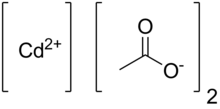
Back استات کادمیوم AZB Cadmiumacetat German استات کادمیم Persian Kadmiumasetaatti Finnish Kadmium asetat ID Acetato di cadmio Italian 酢酸カドミウム Japanese Cadmiumacetaat Dutch Ацетат кадмия Russian Kadmijum acetat Serbo-Croatian

| |
| Names | |
|---|---|
| IUPAC name
Cadmium acetate
| |
| Other names
Cadmium diacetate
| |
| Identifiers | |
3D model (JSmol)
|
|
| ChemSpider | |
| ECHA InfoCard | 100.008.049 |
| EC Number |
|
PubChem CID
|
|
| RTECS number |
|
| UNII |
|
| UN number | 2570 |
CompTox Dashboard (EPA)
|
|
| |
| |
| Properties | |
| Cd(CH3COO)2 (anhydrous) Cd(CH3COO)2·2H2O (dihydrate) | |
| Molar mass | 230.500 g/mol (anhydrous) 266.529 g/mol (dihydrate) |
| Appearance | colorless crystals (anhydrous) white crystals (dihydrate) |
| Odor | acetic acid |
| Density | 2.341 g/cm3 (anhydrous) 2.01 g/cm3 (dihydrate) |
| Melting point | 255 °C (491 °F; 528 K) (anhydrous) dihydrate decomposes at 130°C [1] |
| soluble (anhydrous), very soluble (dihydrate) | |
| Solubility | soluble in methanol, ethanol (anhydrous) soluble in ethanol (dihydrate) |
| -83.7·10−6 cm3/mol | |
| Structure | |
| monoclinic | |
| Hazards | |
| GHS labelling: | |
  
| |
| Warning | |
| H302, H312, H332, H410 | |
| P261, P264, P270, P271, P273, P280, P301+P312, P302+P352, P304+P312, P304+P340, P312, P322, P330, P363, P391, P501 | |
| NFPA 704 (fire diamond) | |
| NIOSH (US health exposure limits): | |
PEL (Permissible)
|
[1910.1027] TWA 0.005 mg/m3 (as Cd)[2] |
REL (Recommended)
|
Ca[2] |
IDLH (Immediate danger)
|
Ca [9 mg/m3 (as Cd)][2] |
| Related compounds | |
Other anions
|
Cadmium fluoride Cadmium chloride Cadmium bromide Cadmium iodide |
Other cations
|
Zinc acetate Mercury(II) acetate Silver acetate |
Except where otherwise noted, data are given for materials in their standard state (at 25 °C [77 °F], 100 kPa).
| |
Cadmium acetate is the chemical compound with the formula Cd(O2CCH3)2(H2O)2. The compound is marketed both as the anhydrous form and as a dihydrate, both of which are white or colorless. Only the dihydrate has been verified by X-ray crystallography.
- ^ Lide, David R. (1998). Handbook of Chemistry and Physics (87 ed.). Boca Raton, Florida: CRC Press. p. 447. ISBN 0-8493-0594-2.
- ^ a b c NIOSH Pocket Guide to Chemical Hazards. "#0087". National Institute for Occupational Safety and Health (NIOSH).
© MMXXIII Rich X Search. We shall prevail. All rights reserved. Rich X Search
